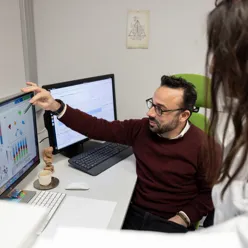in Norwegian
Node leaders: Gonzalo S. Nido and Dimitrios Kleftogiannis
Dr. Gonzalo S. Nido is a senior researcher in computational biology at the University of Bergen, with more than a decade of experience in the analysis of multiomic datasets, including genomics, epigenomics, transcriptomics, and proteomics, as well as single-cell omics, and data integration. His work has made important advances, particularly in the field of PD transcriptomics.
Dr. Dimitrios Kleftogiannis is a senior bioinformatician at the University of Bergen. His work focuses on the development and application of computational approaches to dissect omics datasets from Next Generation Sequencing (NGS), as well as mass cytometry (CyTOF) and imaging mass cytometry (IMC) technologies. He is also interested in the application of machine learning for biomarker discoveries in multiple sclerosis.
The concept of systems medicine in neurology is the backbone of Neuro-SysMed. Addressing the complexity of neurodegenerative and neuroinflammatory diseases requires the ability to analyse and integrate big datasets of multimodal information, encompassing epidemiological, clinical, molecular, and socioeconomic data. Leveraging the wealth of data collected through our clinical and translational activities, and utilising supervised and unsupervised data-analysis models, including artificial intelligence (AI), the Systems Biology & Bioinformatics (SBB) Node is developing specific and sensitive biomarker systems. These systems aim to enable and refine early and precise diagnosis, stratification, and prediction of treatment response.
Recent advances:
The ParkOme Initiative: Integrates multiomics and clinicopathological data to understand Parkinson’s disease (PD) and discover biomarkers and treatment targets. This involves mapping data layers (genome, epigenome, transcriptome, etc.) and using high-throughput single-cell analyses, pathology-guided single-cell transcriptomics, and Xenium spatial transcriptomics.
Multiple Sclerosis Single-Cell Omics: Combines single-cell omics with clinicopathological data to understand MS mechanisms. Advanced machine learning methods characterise immune landscapes in MS patients undergoing therapies like rituximab and aHSCT. High-dimensional cytometry and 10X Genomics platforms are used to establish patient-centric treatment foundations.
Recent key milestones:
- Single-Nucleus RNA Sequencing: Applied to nearly 300,000 nuclei from individuals with PD and other conditions, identifying novel cell-specific gene expression changes.
- PD Stratification: Identified two PD subtypes based on neuronal respiratory complex I deficiency, with distinct molecular and clinical profiles.
- Transcriptome Mapping: Mapped the full transcriptome of over 1300 brains from neurodegenerative disease patients, with publications and a public database expected in 2025.
- MS Single-Cell Analysis: Collected and analysed over 200 million single cells from MS patients, providing insights into immune system reconstitution.
- Funding and Platforms: Secured funding for investigating peripheral blood immunological signatures in MS and established a multimodal omics analysis platform. Additional funding was obtained for single-cell transcriptomics in PSP, CBD, and DLB, and for a high-resolution spatial transcriptomics platform.
The SBB Node’s data, analyses, and computational software have led to several publications in high-impact journals and presentations at major international conferences, garnering significant interest and recognition.
